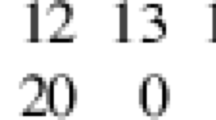Abstract
A classical recursive construction for mutually orthogonal latin squares (MOLS) is shown to hold more generally for a class of permutation codes of length n and minimum distance \(n-1\). When such codes of length \(p+1\) are included as ingredients, we obtain a general lower bound \(M(n,n-1) \ge n^{1.0797}\) for large n, gaining a small improvement on the guarantee given from MOLS.

Similar content being viewed by others
References
Abel R.J.R.: Existence of five MOLS of orders 18 and 60. J. Comb. Des. 23, 135–139 (2015).
Bereg S.: Extending permutation arrays for even prime powers. Manuscript (2017).
Bereg S., Morales L., Sudborough I.H.: Extending permutation arrays: improving MOLS bounds. Des. Codes Cryptogr. 83, 661–683 (2017).
Beth T.: Eine Bemerkung zur Abschätzung der Anzahl orthogonaler lateinischer Quadrate mittels Siebverfahren. Abh. Math. Sem. Univ. Hamburg 53, 284–288 (1983).
Bierbrauer J., Metsch K.: A bound on permutation codes. Electron. J. Comb. 20, P6, 12 pp. (2013).
Chowla S., Erdős P., Strauss E.G.: On the maximal number of pairwise orthogonal latin squres of a given order. Can. J. Math. 12, 204–208 (1960).
Chu W., Colbourn C.J., Dukes P.J.: Permutation codes for powerline communication. Des. Codes Cryptogr. 32, 51–64 (2004).
Colbourn C.J., Dinitz J.H.: Making the MOLS Table. Computational and Constructive Design Theory. Mathematics Application, vol. 67–134, p. 368. Kluwer, Dordrecht (1996).
Colbourn C.J., Kløve T., Ling A.C.H.: Permutation arrays for powerline communication and mutually orthogonal Latin squares. IEEE Trans. Inf. Theory 50, 1289–1291 (2004).
Deza M., Vanstone S.A.: Bounds for permutation arrays. J. Stat. Plan. Inference 2, 197–209 (1978).
Ding C., Fu F.-W., Kløve T., Wei V.K.-W.: Constructions of permutation arrays. IEEE Trans. Inf. Theory 48, 977–980 (2002).
Frankl P., Deza M.: On the maximum number of permutations with given maximal or minimal distance. J. Comb. Theory A 22, 352–360 (1977).
Huczynska S.: Powerline communication and the 36 officers problem. Philos. Trans. R. Soc. Lond. A 364, 3199–3214 (2006).
Iwaniec H., van de Lune J., te Riele H.J.J.: The limits of Buchstab’s iteration sieve. Nederl. Akad. Wetensch. Indag. Math. 42, 409–417 (1980).
Janiszczak I., Staszewski R.: An Improved Bound for Permutation Arrays of Length 10. Preprint 4. Institute for Experimental Mathematics, University Duisburg-Essen, Duisburg (2008).
Janiszczak I., Staszewski R.: Isometry invariant permutation codes and mutually orthogonal Latin squares. arXiv:1812.06886.
Janiszczak I., Lempken W., Östergård P.R.J., Staszewski R.: Permutation codes invariant under isometries. Des. Codes Cryptogr. 75, 497–507 (2015).
Kløve T.: Classification of permutation codes of length 6 and minimum distance 5. In: Proceedings of the International Symposium on Information Theory Applications, pp. 465–468 (2000).
Montemanni R., Barta J., Smith D.H.: Permutation codes: a new upper bound for M(7,5). In: Yingthawornsuk, T., Adiguzel, O. (eds.) Proceedings of the 2014 International Conference on Informatics and Advanced Computing (ICIAC), pp 1–3. International Academy of Engineers (IA-E) (2014).
Smith D.H., Montemanni R.: A new table of permutation codes. Des. Codes Cryptogr. 63, 241–253 (2012).
Wilson R.M.: Concerning the number of mutually orthogonal Latin squares. Discret. Math. 9, 181–198 (1974).
Acknowledgements
We thank the referees for careful reading and helpful suggestions which improved the presentation.
Author information
Authors and Affiliations
Corresponding author
Additional information
Communicated by C. J. Colbourn.
Publisher's Note
Springer Nature remains neutral with regard to jurisdictional claims in published maps and institutional affiliations.
Research of the first author is supported in part by NSF Award CCF-1718994. Research of the second author is supported by NSERC Grant 312595–2017.
Rights and permissions
About this article
Cite this article
Bereg, S., Dukes, P.J. A lower bound on permutation codes of distance \(n-1\). Des. Codes Cryptogr. 88, 63–72 (2020). https://doi.org/10.1007/s10623-019-00670-5
Received:
Revised:
Accepted:
Published:
Issue Date:
DOI: https://doi.org/10.1007/s10623-019-00670-5



